Impact of Brand Image and Design on Consumer Behavior (Snowboarding)
VerifiedAdded on 2023/04/25
|30
|8293
|295
Dissertation
AI Summary
This dissertation investigates the impact of brand image and product design on consumer behavior within the snowboarding market. The research begins by establishing the significance of brand image and product design, alongside consumer behavior, and then proceeds to explore the factors that influence them. A conceptual framework is presented to illustrate the relationships between product design elements such as durability, ease of use, cost, specifications, and reliability, and their impact on consumer behavior. The study identifies and analyzes issues related to product design and brand image that negatively affect consumer behavior in the snowboarding market. The methodology includes a positivism philosophy, deductive approach, descriptive strategy, and interview research strategy. Primary data was collected, and qualitative data analysis techniques were used to consider consumer opinions. The analysis focuses on the importance of product design and brand image in influencing consumer behavior, particularly emphasizing durability, reliability, and ease of handling as key product specifications. The findings underscore the significance of quality and consistency in brand image, and their impact on consumer behavior. The dissertation concludes with recommendations for improving brand image and product design to positively influence consumer behavior, along with suggestions for future research.
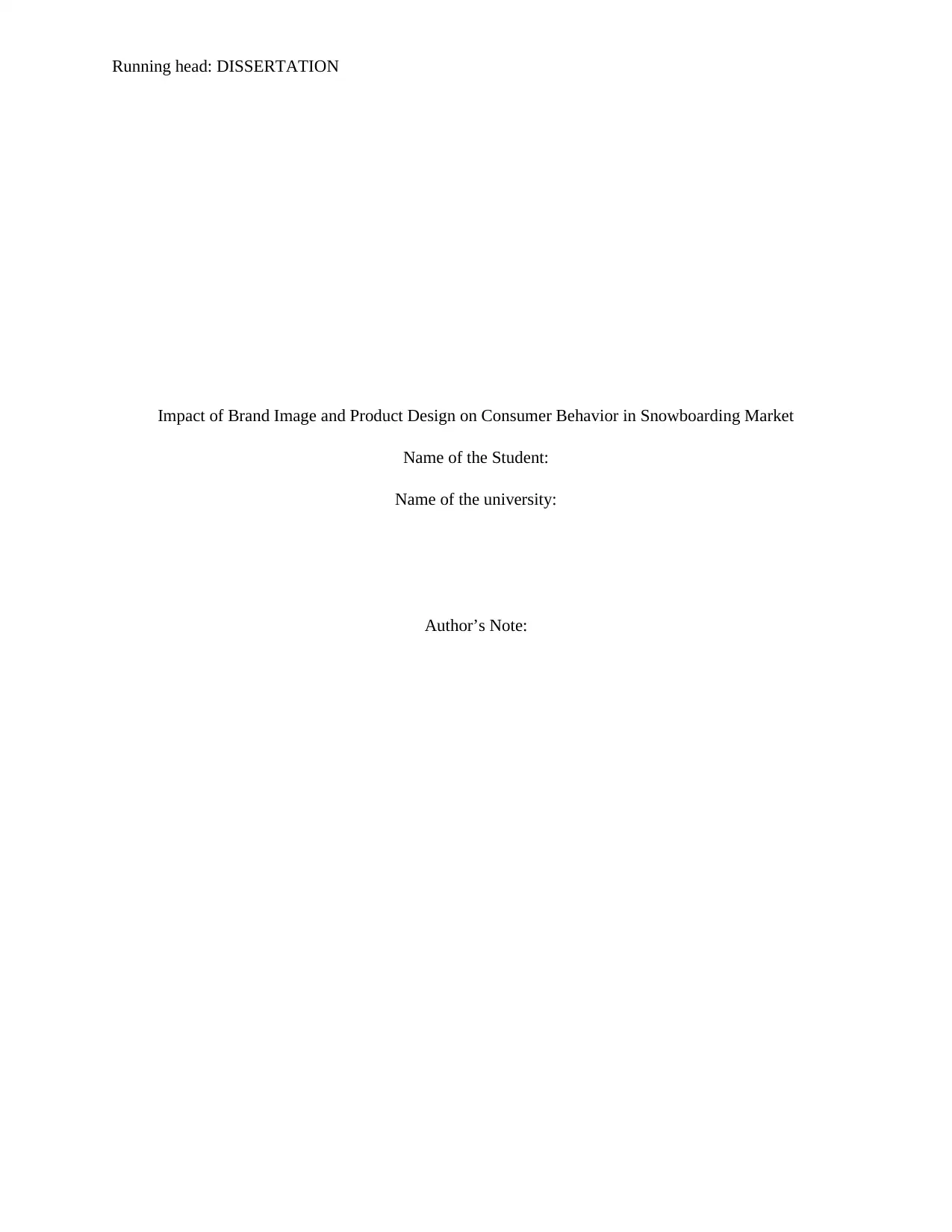
Running head: DISSERTATION
Impact of Brand Image and Product Design on Consumer Behavior in Snowboarding Market
Name of the Student:
Name of the university:
Author’s Note:
Impact of Brand Image and Product Design on Consumer Behavior in Snowboarding Market
Name of the Student:
Name of the university:
Author’s Note:
Paraphrase This Document
Need a fresh take? Get an instant paraphrase of this document with our AI Paraphraser
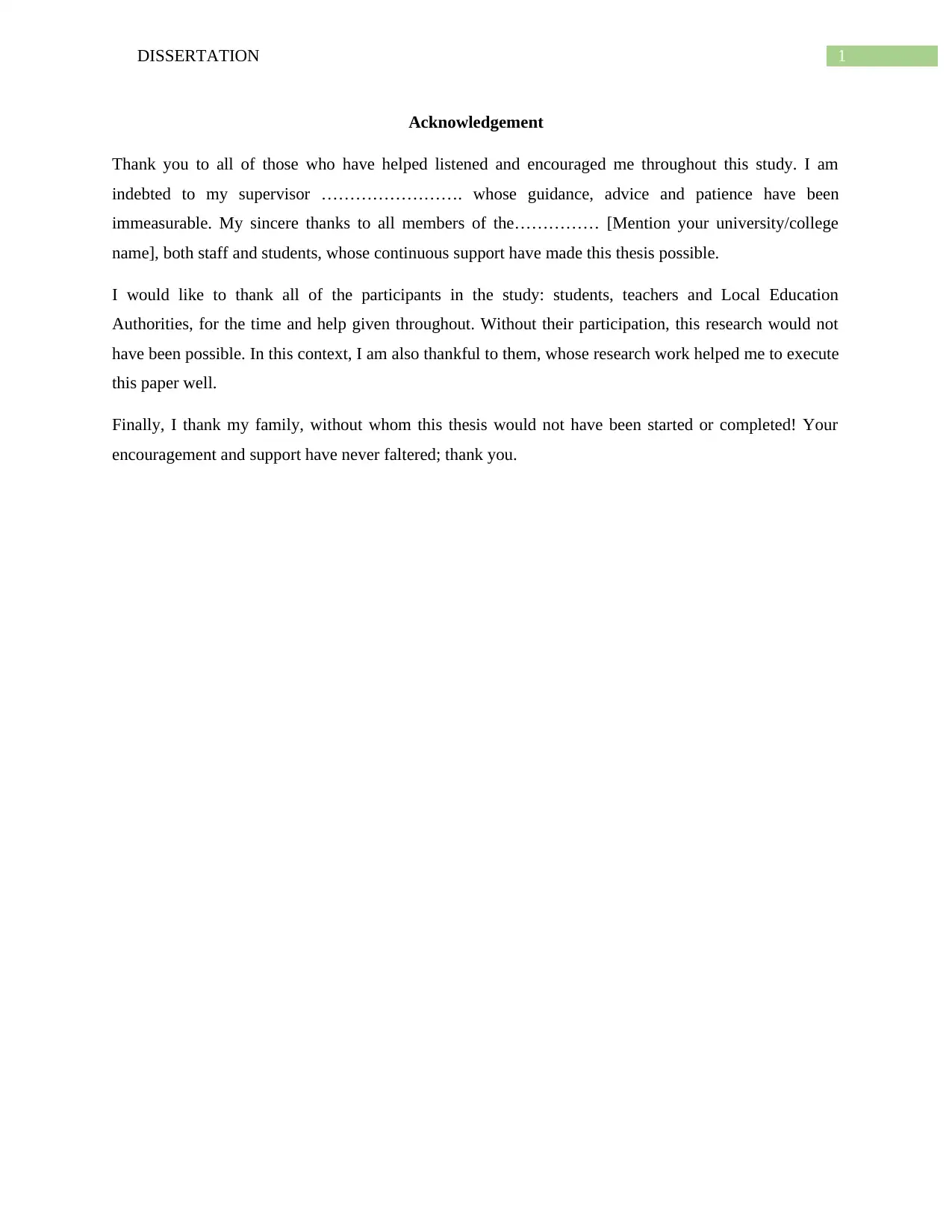
1DISSERTATION
Acknowledgement
Thank you to all of those who have helped listened and encouraged me throughout this study. I am
indebted to my supervisor ……………………. whose guidance, advice and patience have been
immeasurable. My sincere thanks to all members of the…………… [Mention your university/college
name], both staff and students, whose continuous support have made this thesis possible.
I would like to thank all of the participants in the study: students, teachers and Local Education
Authorities, for the time and help given throughout. Without their participation, this research would not
have been possible. In this context, I am also thankful to them, whose research work helped me to execute
this paper well.
Finally, I thank my family, without whom this thesis would not have been started or completed! Your
encouragement and support have never faltered; thank you.
Acknowledgement
Thank you to all of those who have helped listened and encouraged me throughout this study. I am
indebted to my supervisor ……………………. whose guidance, advice and patience have been
immeasurable. My sincere thanks to all members of the…………… [Mention your university/college
name], both staff and students, whose continuous support have made this thesis possible.
I would like to thank all of the participants in the study: students, teachers and Local Education
Authorities, for the time and help given throughout. Without their participation, this research would not
have been possible. In this context, I am also thankful to them, whose research work helped me to execute
this paper well.
Finally, I thank my family, without whom this thesis would not have been started or completed! Your
encouragement and support have never faltered; thank you.
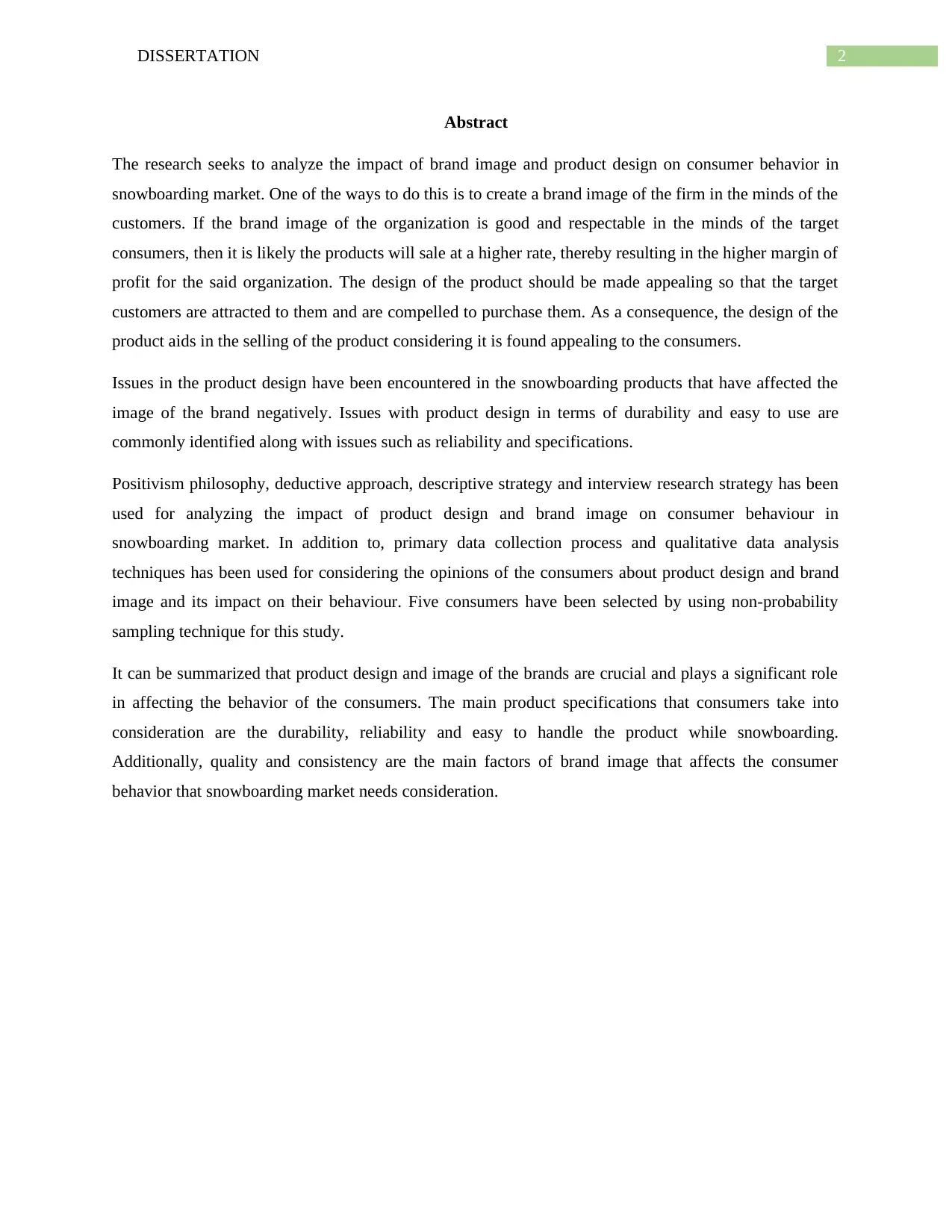
2DISSERTATION
Abstract
The research seeks to analyze the impact of brand image and product design on consumer behavior in
snowboarding market. One of the ways to do this is to create a brand image of the firm in the minds of the
customers. If the brand image of the organization is good and respectable in the minds of the target
consumers, then it is likely the products will sale at a higher rate, thereby resulting in the higher margin of
profit for the said organization. The design of the product should be made appealing so that the target
customers are attracted to them and are compelled to purchase them. As a consequence, the design of the
product aids in the selling of the product considering it is found appealing to the consumers.
Issues in the product design have been encountered in the snowboarding products that have affected the
image of the brand negatively. Issues with product design in terms of durability and easy to use are
commonly identified along with issues such as reliability and specifications.
Positivism philosophy, deductive approach, descriptive strategy and interview research strategy has been
used for analyzing the impact of product design and brand image on consumer behaviour in
snowboarding market. In addition to, primary data collection process and qualitative data analysis
techniques has been used for considering the opinions of the consumers about product design and brand
image and its impact on their behaviour. Five consumers have been selected by using non-probability
sampling technique for this study.
It can be summarized that product design and image of the brands are crucial and plays a significant role
in affecting the behavior of the consumers. The main product specifications that consumers take into
consideration are the durability, reliability and easy to handle the product while snowboarding.
Additionally, quality and consistency are the main factors of brand image that affects the consumer
behavior that snowboarding market needs consideration.
Abstract
The research seeks to analyze the impact of brand image and product design on consumer behavior in
snowboarding market. One of the ways to do this is to create a brand image of the firm in the minds of the
customers. If the brand image of the organization is good and respectable in the minds of the target
consumers, then it is likely the products will sale at a higher rate, thereby resulting in the higher margin of
profit for the said organization. The design of the product should be made appealing so that the target
customers are attracted to them and are compelled to purchase them. As a consequence, the design of the
product aids in the selling of the product considering it is found appealing to the consumers.
Issues in the product design have been encountered in the snowboarding products that have affected the
image of the brand negatively. Issues with product design in terms of durability and easy to use are
commonly identified along with issues such as reliability and specifications.
Positivism philosophy, deductive approach, descriptive strategy and interview research strategy has been
used for analyzing the impact of product design and brand image on consumer behaviour in
snowboarding market. In addition to, primary data collection process and qualitative data analysis
techniques has been used for considering the opinions of the consumers about product design and brand
image and its impact on their behaviour. Five consumers have been selected by using non-probability
sampling technique for this study.
It can be summarized that product design and image of the brands are crucial and plays a significant role
in affecting the behavior of the consumers. The main product specifications that consumers take into
consideration are the durability, reliability and easy to handle the product while snowboarding.
Additionally, quality and consistency are the main factors of brand image that affects the consumer
behavior that snowboarding market needs consideration.
⊘ This is a preview!⊘
Do you want full access?
Subscribe today to unlock all pages.

Trusted by 1+ million students worldwide
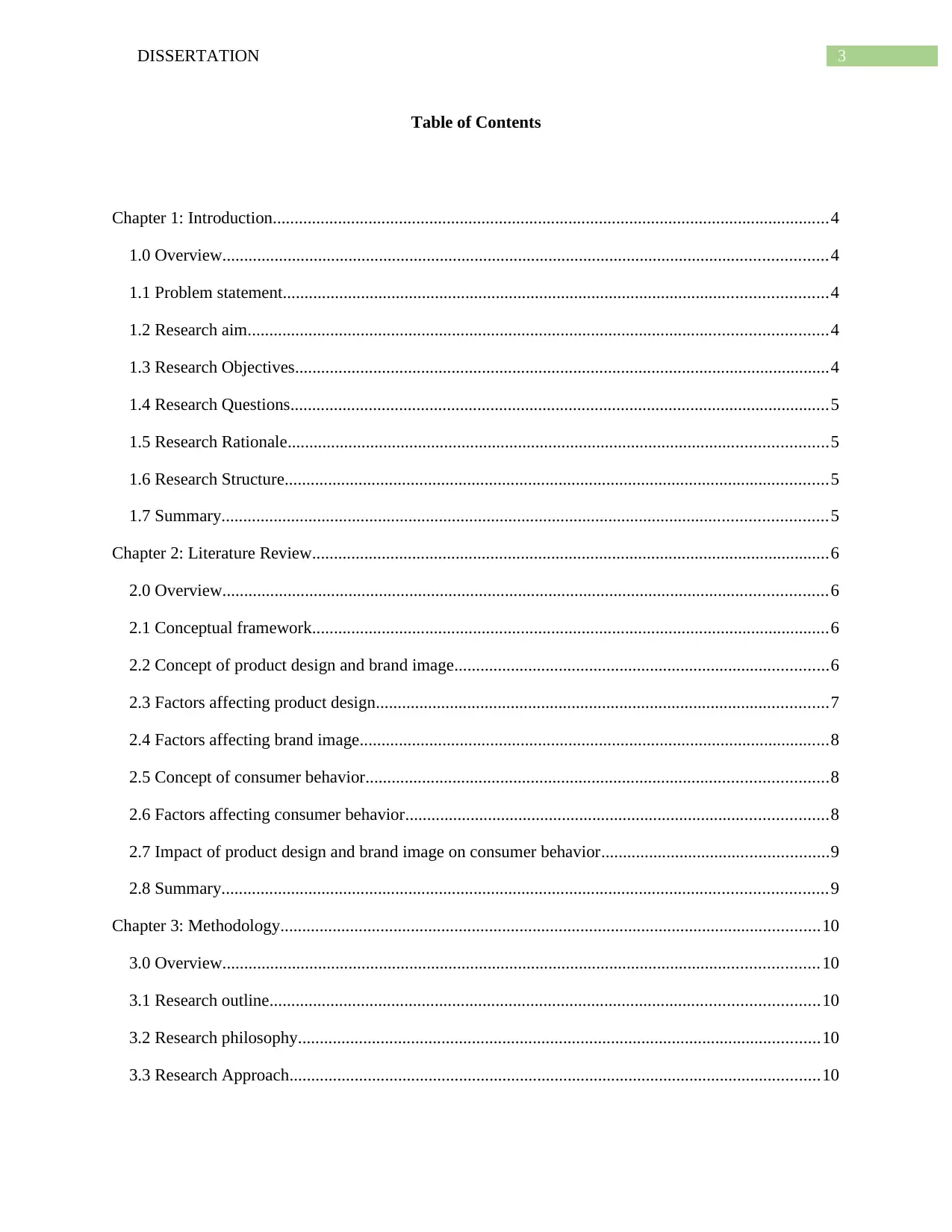
3DISSERTATION
Table of Contents
Chapter 1: Introduction................................................................................................................................4
1.0 Overview...........................................................................................................................................4
1.1 Problem statement.............................................................................................................................4
1.2 Research aim.....................................................................................................................................4
1.3 Research Objectives...........................................................................................................................4
1.4 Research Questions............................................................................................................................5
1.5 Research Rationale............................................................................................................................5
1.6 Research Structure.............................................................................................................................5
1.7 Summary...........................................................................................................................................5
Chapter 2: Literature Review.......................................................................................................................6
2.0 Overview...........................................................................................................................................6
2.1 Conceptual framework.......................................................................................................................6
2.2 Concept of product design and brand image......................................................................................6
2.3 Factors affecting product design........................................................................................................7
2.4 Factors affecting brand image............................................................................................................8
2.5 Concept of consumer behavior..........................................................................................................8
2.6 Factors affecting consumer behavior.................................................................................................8
2.7 Impact of product design and brand image on consumer behavior....................................................9
2.8 Summary...........................................................................................................................................9
Chapter 3: Methodology............................................................................................................................10
3.0 Overview.........................................................................................................................................10
3.1 Research outline..............................................................................................................................10
3.2 Research philosophy........................................................................................................................10
3.3 Research Approach..........................................................................................................................10
Table of Contents
Chapter 1: Introduction................................................................................................................................4
1.0 Overview...........................................................................................................................................4
1.1 Problem statement.............................................................................................................................4
1.2 Research aim.....................................................................................................................................4
1.3 Research Objectives...........................................................................................................................4
1.4 Research Questions............................................................................................................................5
1.5 Research Rationale............................................................................................................................5
1.6 Research Structure.............................................................................................................................5
1.7 Summary...........................................................................................................................................5
Chapter 2: Literature Review.......................................................................................................................6
2.0 Overview...........................................................................................................................................6
2.1 Conceptual framework.......................................................................................................................6
2.2 Concept of product design and brand image......................................................................................6
2.3 Factors affecting product design........................................................................................................7
2.4 Factors affecting brand image............................................................................................................8
2.5 Concept of consumer behavior..........................................................................................................8
2.6 Factors affecting consumer behavior.................................................................................................8
2.7 Impact of product design and brand image on consumer behavior....................................................9
2.8 Summary...........................................................................................................................................9
Chapter 3: Methodology............................................................................................................................10
3.0 Overview.........................................................................................................................................10
3.1 Research outline..............................................................................................................................10
3.2 Research philosophy........................................................................................................................10
3.3 Research Approach..........................................................................................................................10
Paraphrase This Document
Need a fresh take? Get an instant paraphrase of this document with our AI Paraphraser
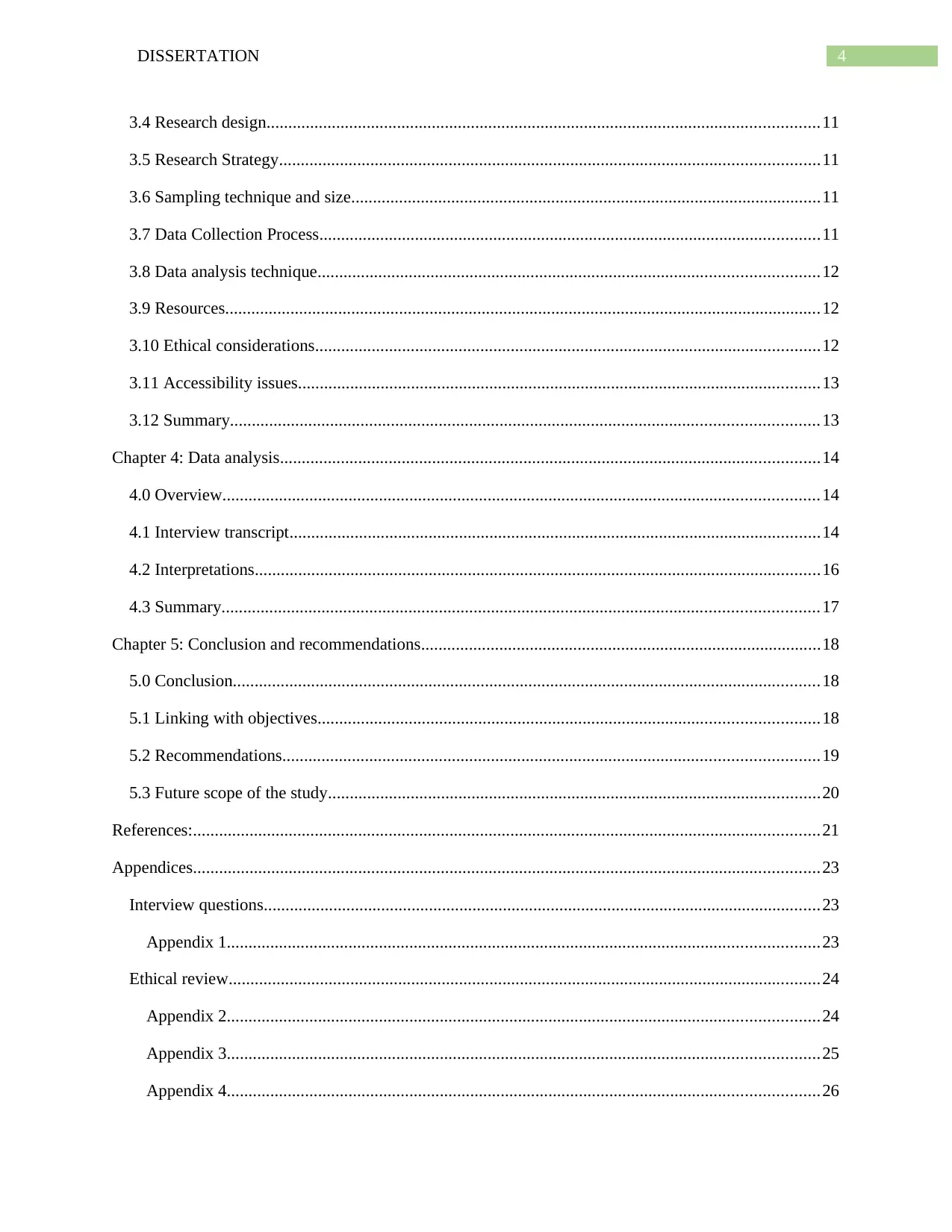
4DISSERTATION
3.4 Research design...............................................................................................................................11
3.5 Research Strategy............................................................................................................................11
3.6 Sampling technique and size............................................................................................................11
3.7 Data Collection Process...................................................................................................................11
3.8 Data analysis technique...................................................................................................................12
3.9 Resources.........................................................................................................................................12
3.10 Ethical considerations....................................................................................................................12
3.11 Accessibility issues........................................................................................................................13
3.12 Summary.......................................................................................................................................13
Chapter 4: Data analysis............................................................................................................................14
4.0 Overview.........................................................................................................................................14
4.1 Interview transcript..........................................................................................................................14
4.2 Interpretations..................................................................................................................................16
4.3 Summary.........................................................................................................................................17
Chapter 5: Conclusion and recommendations............................................................................................18
5.0 Conclusion.......................................................................................................................................18
5.1 Linking with objectives...................................................................................................................18
5.2 Recommendations...........................................................................................................................19
5.3 Future scope of the study.................................................................................................................20
References:................................................................................................................................................21
Appendices................................................................................................................................................23
Interview questions................................................................................................................................23
Appendix 1........................................................................................................................................23
Ethical review........................................................................................................................................24
Appendix 2........................................................................................................................................24
Appendix 3........................................................................................................................................25
Appendix 4........................................................................................................................................26
3.4 Research design...............................................................................................................................11
3.5 Research Strategy............................................................................................................................11
3.6 Sampling technique and size............................................................................................................11
3.7 Data Collection Process...................................................................................................................11
3.8 Data analysis technique...................................................................................................................12
3.9 Resources.........................................................................................................................................12
3.10 Ethical considerations....................................................................................................................12
3.11 Accessibility issues........................................................................................................................13
3.12 Summary.......................................................................................................................................13
Chapter 4: Data analysis............................................................................................................................14
4.0 Overview.........................................................................................................................................14
4.1 Interview transcript..........................................................................................................................14
4.2 Interpretations..................................................................................................................................16
4.3 Summary.........................................................................................................................................17
Chapter 5: Conclusion and recommendations............................................................................................18
5.0 Conclusion.......................................................................................................................................18
5.1 Linking with objectives...................................................................................................................18
5.2 Recommendations...........................................................................................................................19
5.3 Future scope of the study.................................................................................................................20
References:................................................................................................................................................21
Appendices................................................................................................................................................23
Interview questions................................................................................................................................23
Appendix 1........................................................................................................................................23
Ethical review........................................................................................................................................24
Appendix 2........................................................................................................................................24
Appendix 3........................................................................................................................................25
Appendix 4........................................................................................................................................26
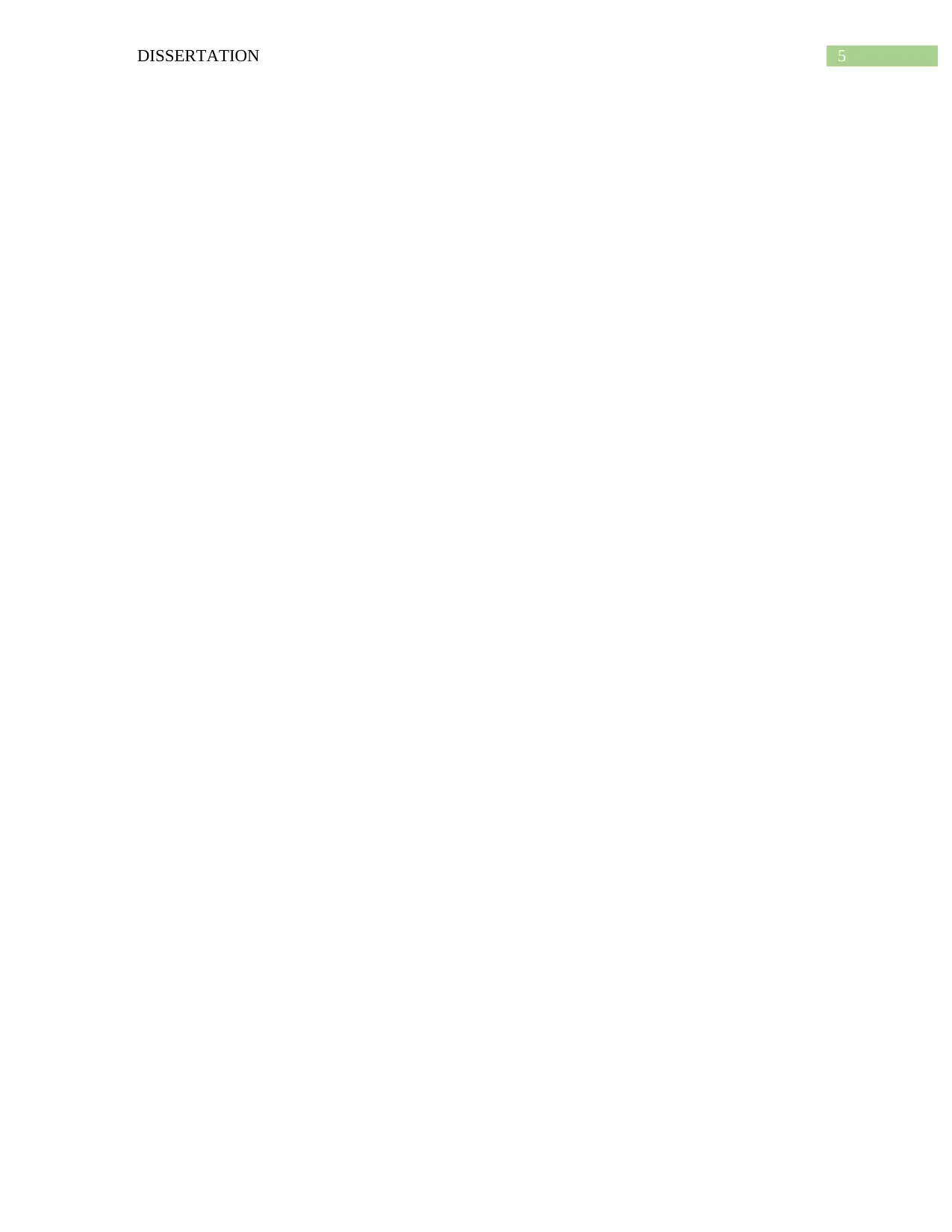
5DISSERTATION
⊘ This is a preview!⊘
Do you want full access?
Subscribe today to unlock all pages.

Trusted by 1+ million students worldwide
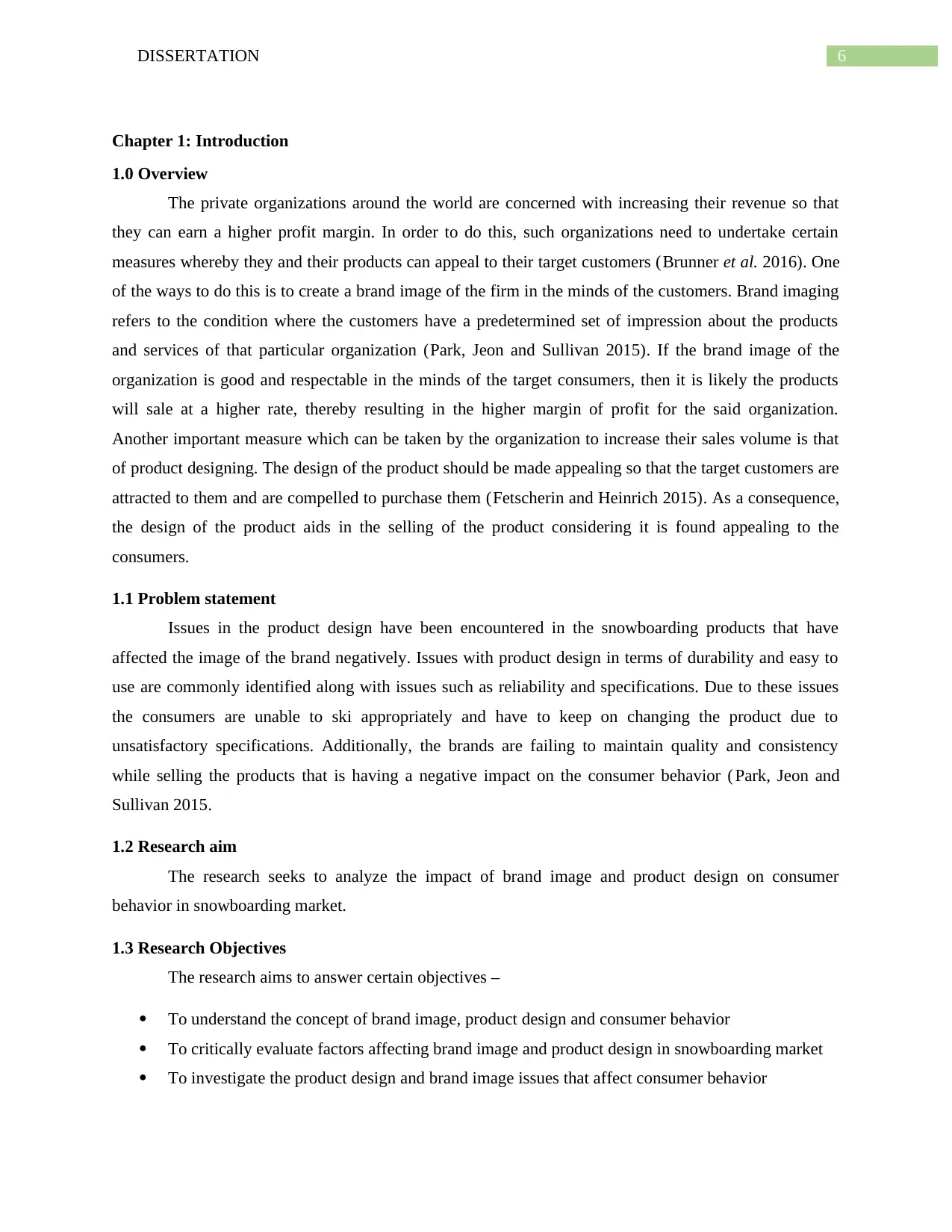
6DISSERTATION
Chapter 1: Introduction
1.0 Overview
The private organizations around the world are concerned with increasing their revenue so that
they can earn a higher profit margin. In order to do this, such organizations need to undertake certain
measures whereby they and their products can appeal to their target customers (Brunner et al. 2016). One
of the ways to do this is to create a brand image of the firm in the minds of the customers. Brand imaging
refers to the condition where the customers have a predetermined set of impression about the products
and services of that particular organization (Park, Jeon and Sullivan 2015). If the brand image of the
organization is good and respectable in the minds of the target consumers, then it is likely the products
will sale at a higher rate, thereby resulting in the higher margin of profit for the said organization.
Another important measure which can be taken by the organization to increase their sales volume is that
of product designing. The design of the product should be made appealing so that the target customers are
attracted to them and are compelled to purchase them (Fetscherin and Heinrich 2015). As a consequence,
the design of the product aids in the selling of the product considering it is found appealing to the
consumers.
1.1 Problem statement
Issues in the product design have been encountered in the snowboarding products that have
affected the image of the brand negatively. Issues with product design in terms of durability and easy to
use are commonly identified along with issues such as reliability and specifications. Due to these issues
the consumers are unable to ski appropriately and have to keep on changing the product due to
unsatisfactory specifications. Additionally, the brands are failing to maintain quality and consistency
while selling the products that is having a negative impact on the consumer behavior ( Park, Jeon and
Sullivan 2015.
1.2 Research aim
The research seeks to analyze the impact of brand image and product design on consumer
behavior in snowboarding market.
1.3 Research Objectives
The research aims to answer certain objectives –
To understand the concept of brand image, product design and consumer behavior
To critically evaluate factors affecting brand image and product design in snowboarding market
To investigate the product design and brand image issues that affect consumer behavior
Chapter 1: Introduction
1.0 Overview
The private organizations around the world are concerned with increasing their revenue so that
they can earn a higher profit margin. In order to do this, such organizations need to undertake certain
measures whereby they and their products can appeal to their target customers (Brunner et al. 2016). One
of the ways to do this is to create a brand image of the firm in the minds of the customers. Brand imaging
refers to the condition where the customers have a predetermined set of impression about the products
and services of that particular organization (Park, Jeon and Sullivan 2015). If the brand image of the
organization is good and respectable in the minds of the target consumers, then it is likely the products
will sale at a higher rate, thereby resulting in the higher margin of profit for the said organization.
Another important measure which can be taken by the organization to increase their sales volume is that
of product designing. The design of the product should be made appealing so that the target customers are
attracted to them and are compelled to purchase them (Fetscherin and Heinrich 2015). As a consequence,
the design of the product aids in the selling of the product considering it is found appealing to the
consumers.
1.1 Problem statement
Issues in the product design have been encountered in the snowboarding products that have
affected the image of the brand negatively. Issues with product design in terms of durability and easy to
use are commonly identified along with issues such as reliability and specifications. Due to these issues
the consumers are unable to ski appropriately and have to keep on changing the product due to
unsatisfactory specifications. Additionally, the brands are failing to maintain quality and consistency
while selling the products that is having a negative impact on the consumer behavior ( Park, Jeon and
Sullivan 2015.
1.2 Research aim
The research seeks to analyze the impact of brand image and product design on consumer
behavior in snowboarding market.
1.3 Research Objectives
The research aims to answer certain objectives –
To understand the concept of brand image, product design and consumer behavior
To critically evaluate factors affecting brand image and product design in snowboarding market
To investigate the product design and brand image issues that affect consumer behavior
Paraphrase This Document
Need a fresh take? Get an instant paraphrase of this document with our AI Paraphraser
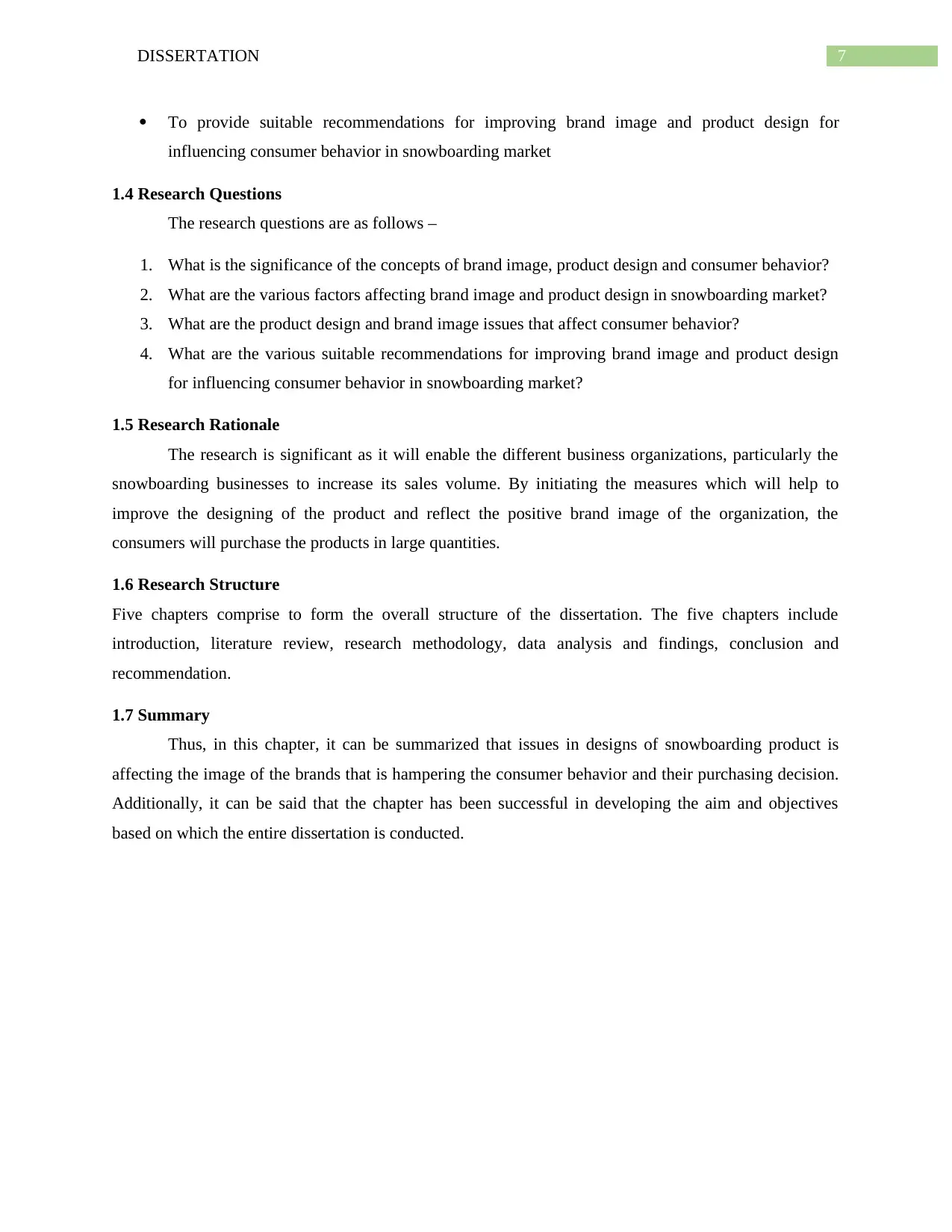
7DISSERTATION
To provide suitable recommendations for improving brand image and product design for
influencing consumer behavior in snowboarding market
1.4 Research Questions
The research questions are as follows –
1. What is the significance of the concepts of brand image, product design and consumer behavior?
2. What are the various factors affecting brand image and product design in snowboarding market?
3. What are the product design and brand image issues that affect consumer behavior?
4. What are the various suitable recommendations for improving brand image and product design
for influencing consumer behavior in snowboarding market?
1.5 Research Rationale
The research is significant as it will enable the different business organizations, particularly the
snowboarding businesses to increase its sales volume. By initiating the measures which will help to
improve the designing of the product and reflect the positive brand image of the organization, the
consumers will purchase the products in large quantities.
1.6 Research Structure
Five chapters comprise to form the overall structure of the dissertation. The five chapters include
introduction, literature review, research methodology, data analysis and findings, conclusion and
recommendation.
1.7 Summary
Thus, in this chapter, it can be summarized that issues in designs of snowboarding product is
affecting the image of the brands that is hampering the consumer behavior and their purchasing decision.
Additionally, it can be said that the chapter has been successful in developing the aim and objectives
based on which the entire dissertation is conducted.
To provide suitable recommendations for improving brand image and product design for
influencing consumer behavior in snowboarding market
1.4 Research Questions
The research questions are as follows –
1. What is the significance of the concepts of brand image, product design and consumer behavior?
2. What are the various factors affecting brand image and product design in snowboarding market?
3. What are the product design and brand image issues that affect consumer behavior?
4. What are the various suitable recommendations for improving brand image and product design
for influencing consumer behavior in snowboarding market?
1.5 Research Rationale
The research is significant as it will enable the different business organizations, particularly the
snowboarding businesses to increase its sales volume. By initiating the measures which will help to
improve the designing of the product and reflect the positive brand image of the organization, the
consumers will purchase the products in large quantities.
1.6 Research Structure
Five chapters comprise to form the overall structure of the dissertation. The five chapters include
introduction, literature review, research methodology, data analysis and findings, conclusion and
recommendation.
1.7 Summary
Thus, in this chapter, it can be summarized that issues in designs of snowboarding product is
affecting the image of the brands that is hampering the consumer behavior and their purchasing decision.
Additionally, it can be said that the chapter has been successful in developing the aim and objectives
based on which the entire dissertation is conducted.
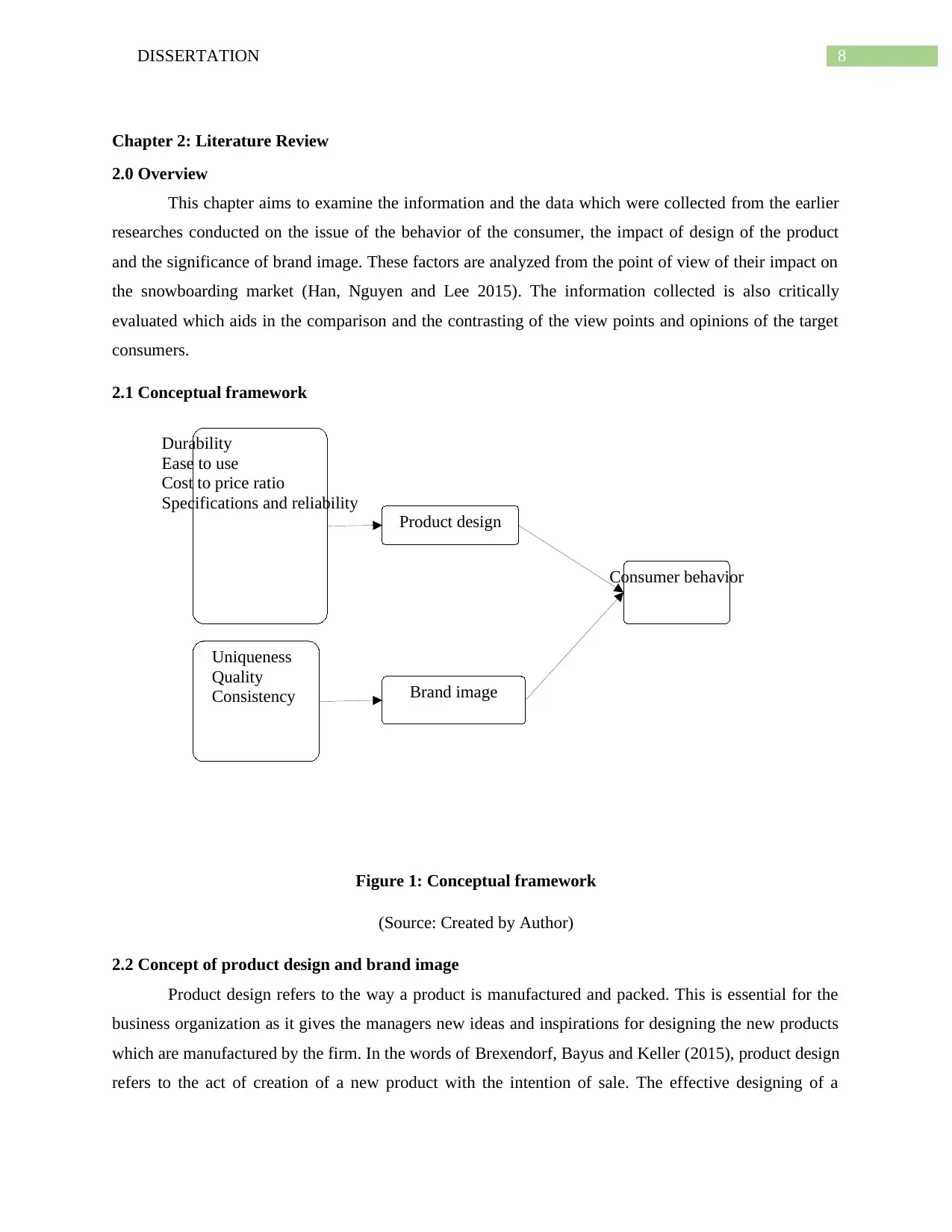
8DISSERTATION
Product design
Durability
Ease to use
Cost to price ratio
Specifications and reliability
Brand image
Uniqueness
Quality
Consistency
Consumer behavior
Chapter 2: Literature Review
2.0 Overview
This chapter aims to examine the information and the data which were collected from the earlier
researches conducted on the issue of the behavior of the consumer, the impact of design of the product
and the significance of brand image. These factors are analyzed from the point of view of their impact on
the snowboarding market (Han, Nguyen and Lee 2015). The information collected is also critically
evaluated which aids in the comparison and the contrasting of the view points and opinions of the target
consumers.
2.1 Conceptual framework
Figure 1: Conceptual framework
(Source: Created by Author)
2.2 Concept of product design and brand image
Product design refers to the way a product is manufactured and packed. This is essential for the
business organization as it gives the managers new ideas and inspirations for designing the new products
which are manufactured by the firm. In the words of Brexendorf, Bayus and Keller (2015), product design
refers to the act of creation of a new product with the intention of sale. The effective designing of a
Product design
Durability
Ease to use
Cost to price ratio
Specifications and reliability
Brand image
Uniqueness
Quality
Consistency
Consumer behavior
Chapter 2: Literature Review
2.0 Overview
This chapter aims to examine the information and the data which were collected from the earlier
researches conducted on the issue of the behavior of the consumer, the impact of design of the product
and the significance of brand image. These factors are analyzed from the point of view of their impact on
the snowboarding market (Han, Nguyen and Lee 2015). The information collected is also critically
evaluated which aids in the comparison and the contrasting of the view points and opinions of the target
consumers.
2.1 Conceptual framework
Figure 1: Conceptual framework
(Source: Created by Author)
2.2 Concept of product design and brand image
Product design refers to the way a product is manufactured and packed. This is essential for the
business organization as it gives the managers new ideas and inspirations for designing the new products
which are manufactured by the firm. In the words of Brexendorf, Bayus and Keller (2015), product design
refers to the act of creation of a new product with the intention of sale. The effective designing of a
⊘ This is a preview!⊘
Do you want full access?
Subscribe today to unlock all pages.

Trusted by 1+ million students worldwide
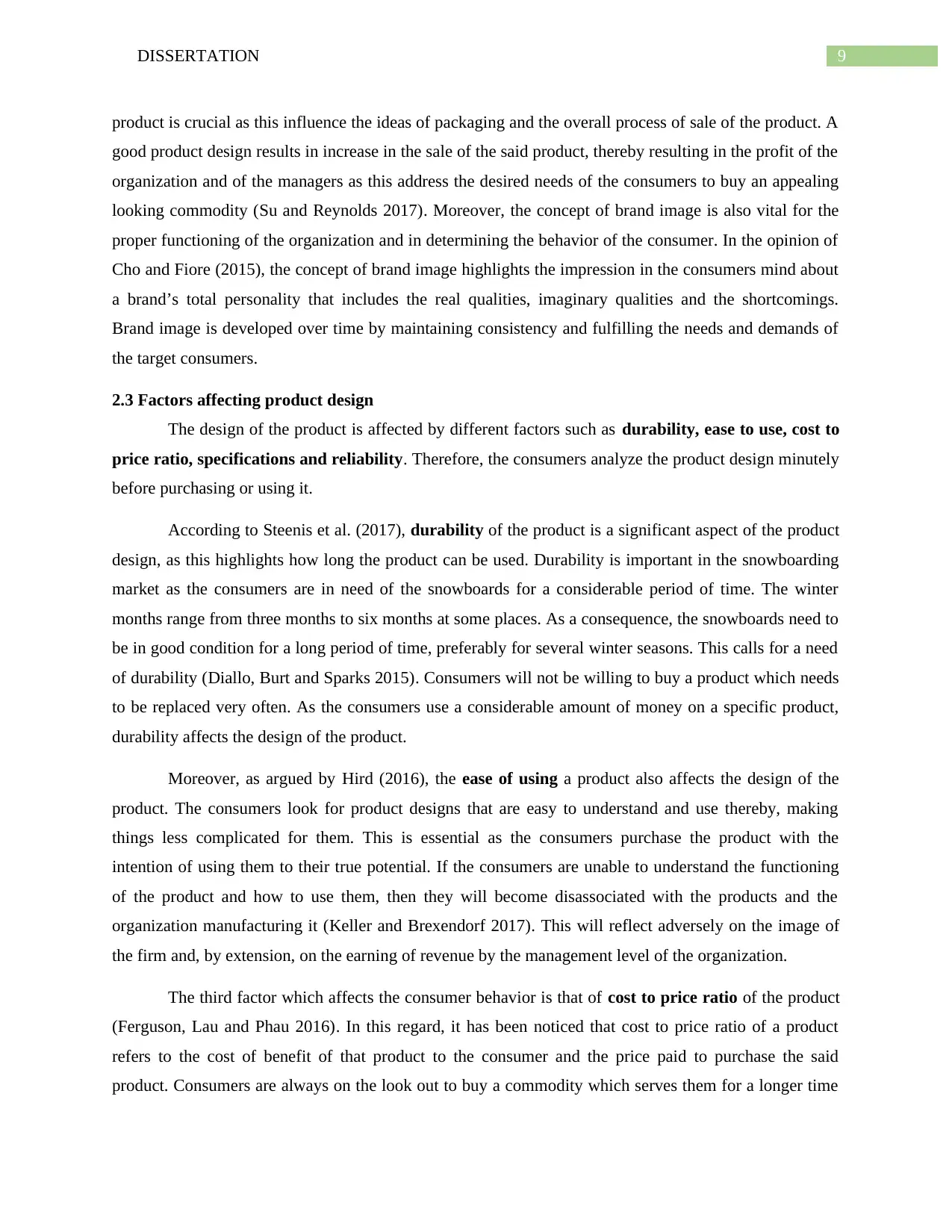
9DISSERTATION
product is crucial as this influence the ideas of packaging and the overall process of sale of the product. A
good product design results in increase in the sale of the said product, thereby resulting in the profit of the
organization and of the managers as this address the desired needs of the consumers to buy an appealing
looking commodity (Su and Reynolds 2017). Moreover, the concept of brand image is also vital for the
proper functioning of the organization and in determining the behavior of the consumer. In the opinion of
Cho and Fiore (2015), the concept of brand image highlights the impression in the consumers mind about
a brand’s total personality that includes the real qualities, imaginary qualities and the shortcomings.
Brand image is developed over time by maintaining consistency and fulfilling the needs and demands of
the target consumers.
2.3 Factors affecting product design
The design of the product is affected by different factors such as durability, ease to use, cost to
price ratio, specifications and reliability. Therefore, the consumers analyze the product design minutely
before purchasing or using it.
According to Steenis et al. (2017), durability of the product is a significant aspect of the product
design, as this highlights how long the product can be used. Durability is important in the snowboarding
market as the consumers are in need of the snowboards for a considerable period of time. The winter
months range from three months to six months at some places. As a consequence, the snowboards need to
be in good condition for a long period of time, preferably for several winter seasons. This calls for a need
of durability (Diallo, Burt and Sparks 2015). Consumers will not be willing to buy a product which needs
to be replaced very often. As the consumers use a considerable amount of money on a specific product,
durability affects the design of the product.
Moreover, as argued by Hird (2016), the ease of using a product also affects the design of the
product. The consumers look for product designs that are easy to understand and use thereby, making
things less complicated for them. This is essential as the consumers purchase the product with the
intention of using them to their true potential. If the consumers are unable to understand the functioning
of the product and how to use them, then they will become disassociated with the products and the
organization manufacturing it (Keller and Brexendorf 2017). This will reflect adversely on the image of
the firm and, by extension, on the earning of revenue by the management level of the organization.
The third factor which affects the consumer behavior is that of cost to price ratio of the product
(Ferguson, Lau and Phau 2016). In this regard, it has been noticed that cost to price ratio of a product
refers to the cost of benefit of that product to the consumer and the price paid to purchase the said
product. Consumers are always on the look out to buy a commodity which serves them for a longer time
product is crucial as this influence the ideas of packaging and the overall process of sale of the product. A
good product design results in increase in the sale of the said product, thereby resulting in the profit of the
organization and of the managers as this address the desired needs of the consumers to buy an appealing
looking commodity (Su and Reynolds 2017). Moreover, the concept of brand image is also vital for the
proper functioning of the organization and in determining the behavior of the consumer. In the opinion of
Cho and Fiore (2015), the concept of brand image highlights the impression in the consumers mind about
a brand’s total personality that includes the real qualities, imaginary qualities and the shortcomings.
Brand image is developed over time by maintaining consistency and fulfilling the needs and demands of
the target consumers.
2.3 Factors affecting product design
The design of the product is affected by different factors such as durability, ease to use, cost to
price ratio, specifications and reliability. Therefore, the consumers analyze the product design minutely
before purchasing or using it.
According to Steenis et al. (2017), durability of the product is a significant aspect of the product
design, as this highlights how long the product can be used. Durability is important in the snowboarding
market as the consumers are in need of the snowboards for a considerable period of time. The winter
months range from three months to six months at some places. As a consequence, the snowboards need to
be in good condition for a long period of time, preferably for several winter seasons. This calls for a need
of durability (Diallo, Burt and Sparks 2015). Consumers will not be willing to buy a product which needs
to be replaced very often. As the consumers use a considerable amount of money on a specific product,
durability affects the design of the product.
Moreover, as argued by Hird (2016), the ease of using a product also affects the design of the
product. The consumers look for product designs that are easy to understand and use thereby, making
things less complicated for them. This is essential as the consumers purchase the product with the
intention of using them to their true potential. If the consumers are unable to understand the functioning
of the product and how to use them, then they will become disassociated with the products and the
organization manufacturing it (Keller and Brexendorf 2017). This will reflect adversely on the image of
the firm and, by extension, on the earning of revenue by the management level of the organization.
The third factor which affects the consumer behavior is that of cost to price ratio of the product
(Ferguson, Lau and Phau 2016). In this regard, it has been noticed that cost to price ratio of a product
refers to the cost of benefit of that product to the consumer and the price paid to purchase the said
product. Consumers are always on the look out to buy a commodity which serves them for a longer time
Paraphrase This Document
Need a fresh take? Get an instant paraphrase of this document with our AI Paraphraser
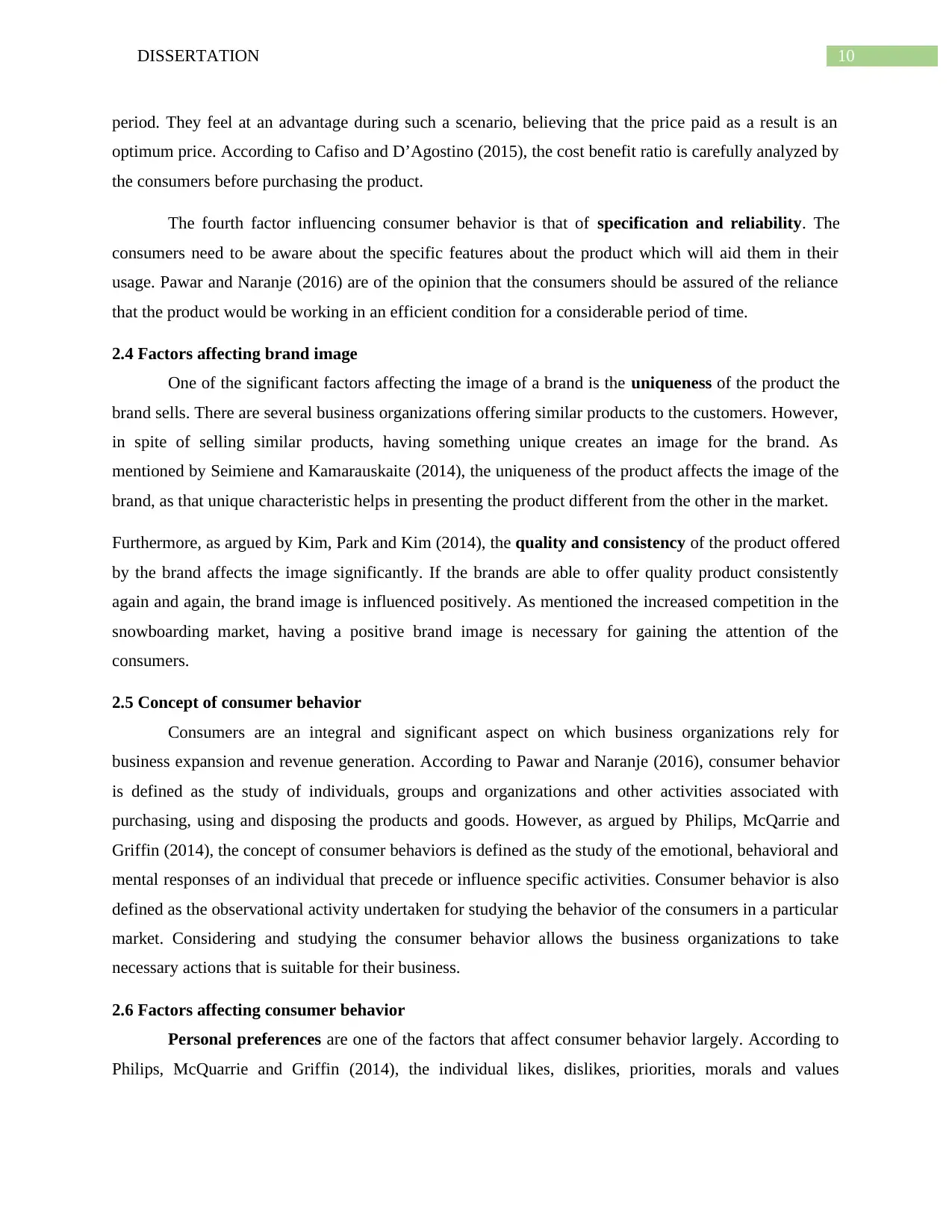
10DISSERTATION
period. They feel at an advantage during such a scenario, believing that the price paid as a result is an
optimum price. According to Cafiso and D’Agostino (2015), the cost benefit ratio is carefully analyzed by
the consumers before purchasing the product.
The fourth factor influencing consumer behavior is that of specification and reliability. The
consumers need to be aware about the specific features about the product which will aid them in their
usage. Pawar and Naranje (2016) are of the opinion that the consumers should be assured of the reliance
that the product would be working in an efficient condition for a considerable period of time.
2.4 Factors affecting brand image
One of the significant factors affecting the image of a brand is the uniqueness of the product the
brand sells. There are several business organizations offering similar products to the customers. However,
in spite of selling similar products, having something unique creates an image for the brand. As
mentioned by Seimiene and Kamarauskaite (2014), the uniqueness of the product affects the image of the
brand, as that unique characteristic helps in presenting the product different from the other in the market.
Furthermore, as argued by Kim, Park and Kim (2014), the quality and consistency of the product offered
by the brand affects the image significantly. If the brands are able to offer quality product consistently
again and again, the brand image is influenced positively. As mentioned the increased competition in the
snowboarding market, having a positive brand image is necessary for gaining the attention of the
consumers.
2.5 Concept of consumer behavior
Consumers are an integral and significant aspect on which business organizations rely for
business expansion and revenue generation. According to Pawar and Naranje (2016), consumer behavior
is defined as the study of individuals, groups and organizations and other activities associated with
purchasing, using and disposing the products and goods. However, as argued by Philips, McQarrie and
Griffin (2014), the concept of consumer behaviors is defined as the study of the emotional, behavioral and
mental responses of an individual that precede or influence specific activities. Consumer behavior is also
defined as the observational activity undertaken for studying the behavior of the consumers in a particular
market. Considering and studying the consumer behavior allows the business organizations to take
necessary actions that is suitable for their business.
2.6 Factors affecting consumer behavior
Personal preferences are one of the factors that affect consumer behavior largely. According to
Philips, McQuarrie and Griffin (2014), the individual likes, dislikes, priorities, morals and values
period. They feel at an advantage during such a scenario, believing that the price paid as a result is an
optimum price. According to Cafiso and D’Agostino (2015), the cost benefit ratio is carefully analyzed by
the consumers before purchasing the product.
The fourth factor influencing consumer behavior is that of specification and reliability. The
consumers need to be aware about the specific features about the product which will aid them in their
usage. Pawar and Naranje (2016) are of the opinion that the consumers should be assured of the reliance
that the product would be working in an efficient condition for a considerable period of time.
2.4 Factors affecting brand image
One of the significant factors affecting the image of a brand is the uniqueness of the product the
brand sells. There are several business organizations offering similar products to the customers. However,
in spite of selling similar products, having something unique creates an image for the brand. As
mentioned by Seimiene and Kamarauskaite (2014), the uniqueness of the product affects the image of the
brand, as that unique characteristic helps in presenting the product different from the other in the market.
Furthermore, as argued by Kim, Park and Kim (2014), the quality and consistency of the product offered
by the brand affects the image significantly. If the brands are able to offer quality product consistently
again and again, the brand image is influenced positively. As mentioned the increased competition in the
snowboarding market, having a positive brand image is necessary for gaining the attention of the
consumers.
2.5 Concept of consumer behavior
Consumers are an integral and significant aspect on which business organizations rely for
business expansion and revenue generation. According to Pawar and Naranje (2016), consumer behavior
is defined as the study of individuals, groups and organizations and other activities associated with
purchasing, using and disposing the products and goods. However, as argued by Philips, McQarrie and
Griffin (2014), the concept of consumer behaviors is defined as the study of the emotional, behavioral and
mental responses of an individual that precede or influence specific activities. Consumer behavior is also
defined as the observational activity undertaken for studying the behavior of the consumers in a particular
market. Considering and studying the consumer behavior allows the business organizations to take
necessary actions that is suitable for their business.
2.6 Factors affecting consumer behavior
Personal preferences are one of the factors that affect consumer behavior largely. According to
Philips, McQuarrie and Griffin (2014), the individual likes, dislikes, priorities, morals and values
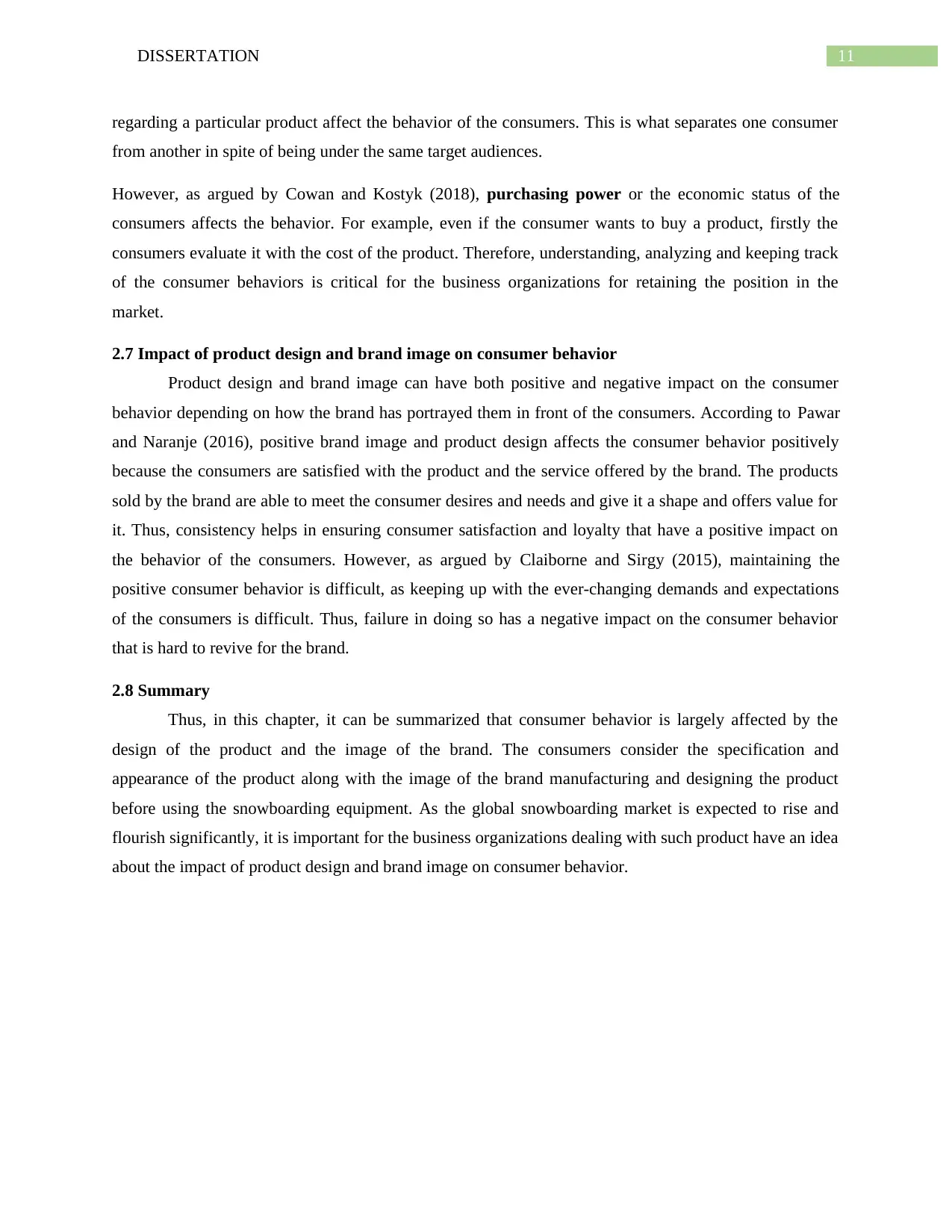
11DISSERTATION
regarding a particular product affect the behavior of the consumers. This is what separates one consumer
from another in spite of being under the same target audiences.
However, as argued by Cowan and Kostyk (2018), purchasing power or the economic status of the
consumers affects the behavior. For example, even if the consumer wants to buy a product, firstly the
consumers evaluate it with the cost of the product. Therefore, understanding, analyzing and keeping track
of the consumer behaviors is critical for the business organizations for retaining the position in the
market.
2.7 Impact of product design and brand image on consumer behavior
Product design and brand image can have both positive and negative impact on the consumer
behavior depending on how the brand has portrayed them in front of the consumers. According to Pawar
and Naranje (2016), positive brand image and product design affects the consumer behavior positively
because the consumers are satisfied with the product and the service offered by the brand. The products
sold by the brand are able to meet the consumer desires and needs and give it a shape and offers value for
it. Thus, consistency helps in ensuring consumer satisfaction and loyalty that have a positive impact on
the behavior of the consumers. However, as argued by Claiborne and Sirgy (2015), maintaining the
positive consumer behavior is difficult, as keeping up with the ever-changing demands and expectations
of the consumers is difficult. Thus, failure in doing so has a negative impact on the consumer behavior
that is hard to revive for the brand.
2.8 Summary
Thus, in this chapter, it can be summarized that consumer behavior is largely affected by the
design of the product and the image of the brand. The consumers consider the specification and
appearance of the product along with the image of the brand manufacturing and designing the product
before using the snowboarding equipment. As the global snowboarding market is expected to rise and
flourish significantly, it is important for the business organizations dealing with such product have an idea
about the impact of product design and brand image on consumer behavior.
regarding a particular product affect the behavior of the consumers. This is what separates one consumer
from another in spite of being under the same target audiences.
However, as argued by Cowan and Kostyk (2018), purchasing power or the economic status of the
consumers affects the behavior. For example, even if the consumer wants to buy a product, firstly the
consumers evaluate it with the cost of the product. Therefore, understanding, analyzing and keeping track
of the consumer behaviors is critical for the business organizations for retaining the position in the
market.
2.7 Impact of product design and brand image on consumer behavior
Product design and brand image can have both positive and negative impact on the consumer
behavior depending on how the brand has portrayed them in front of the consumers. According to Pawar
and Naranje (2016), positive brand image and product design affects the consumer behavior positively
because the consumers are satisfied with the product and the service offered by the brand. The products
sold by the brand are able to meet the consumer desires and needs and give it a shape and offers value for
it. Thus, consistency helps in ensuring consumer satisfaction and loyalty that have a positive impact on
the behavior of the consumers. However, as argued by Claiborne and Sirgy (2015), maintaining the
positive consumer behavior is difficult, as keeping up with the ever-changing demands and expectations
of the consumers is difficult. Thus, failure in doing so has a negative impact on the consumer behavior
that is hard to revive for the brand.
2.8 Summary
Thus, in this chapter, it can be summarized that consumer behavior is largely affected by the
design of the product and the image of the brand. The consumers consider the specification and
appearance of the product along with the image of the brand manufacturing and designing the product
before using the snowboarding equipment. As the global snowboarding market is expected to rise and
flourish significantly, it is important for the business organizations dealing with such product have an idea
about the impact of product design and brand image on consumer behavior.
⊘ This is a preview!⊘
Do you want full access?
Subscribe today to unlock all pages.

Trusted by 1+ million students worldwide
1 out of 30
Related Documents
Your All-in-One AI-Powered Toolkit for Academic Success.
+13062052269
info@desklib.com
Available 24*7 on WhatsApp / Email
![[object Object]](/_next/static/media/star-bottom.7253800d.svg)
Unlock your academic potential
Copyright © 2020–2025 A2Z Services. All Rights Reserved. Developed and managed by ZUCOL.





